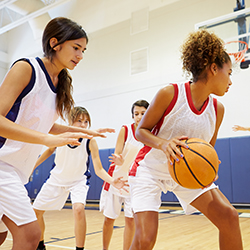 In 1891, Dr. James Naismith invented the game of basketball to condition athletes during cold months in Massachusetts. He used a soccer ball and two peach baskets nailed to the gym balcony. Today’s fast-paced game of basketball can result in acute/traumatic or overuse injuries. It is estimated that more than 1.6 million injuries are associated with basketball each year.
In 1891, Dr. James Naismith invented the game of basketball to condition athletes during cold months in Massachusetts. He used a soccer ball and two peach baskets nailed to the gym balcony. Today’s fast-paced game of basketball can result in acute/traumatic or overuse injuries. It is estimated that more than 1.6 million injuries are associated with basketball each year.
A study of high school basketball players by the National Athletic Trainers Association (NATA) provides injury data:
- 22% of all male basketball players sustained at least one time-loss injury each year.
- 42% of the injuries were to the ankle/foot, 11% hip and thigh, and 9% knee.
- Sprains were the most common injury (43%).
- General trauma was the second most common type of injury (22%).
- 60% of the injuries occurred during practice, highlighting the need to warm up.
- 59% of game-related injuries occurred during the second half of the game, which identifies fatigue as a predisposing factor.
The following safety precautions are recommended to help prevent basketball injuries:
- Have a preseason physical examination.
- Maintain balanced fitness during the off-season with aerobic exercise, strength and flexibility training.
- Warm up and stretch prior to playing or training.
- Use appropriate equipment: supportive, non-skid basketball shoes, ankle supports, protective knee and elbow pads, mouth guard, and safety glasses.
- Ensure a safe environment: courts free of debris, proper lighting, padded poles, and boundaries away from structures.
- Learn and use proper techniques for passing and scoring.
- Hydrate adequately: drink 24 ounces of fluid 2 hours before exercise and 8 ounces of water every 20 minutes during exercise.
- Avoid overuse injuries: decrease training time and intensity if feeling pain or discomfort.
- Coaches and/or athletic trainers knowledgeable and able to provide first aid for minor injuries and assess medical emergencies.
- Plan in place for emergencies: the location of the nearest DOC for any musculoskeletal injury or overuse condition, and the location of the nearest ER for other, non-orthopedic medical emergencies.
- Return to play after any injury when cleared by a DOC orthopedic surgeon, PA, physical therapist or other healthcare professional.
Sources:
Basketball Injury Prevention – OrthoInfo.org
Preventing Basketball Injuries – StopSportsInjuries.org


